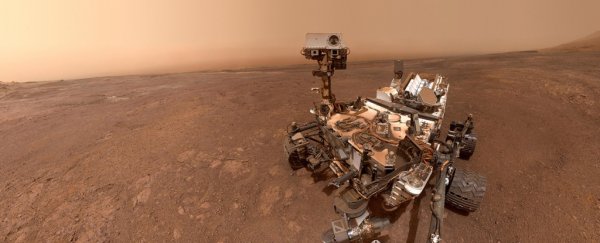Curiosity has been puttering away out there on Mars since August 2012, but she still has a few surprises tucked inside her weathered chassis.
Scientists have just figured out how to use the rover's instruments to measure the gravity of the ground it's been rolling across.
In turn, this has allowed scientists for the first time to make an accurate measurement of the density of the rock under Curiosity's wheels, along with the rock's weight per cubic metre.
"Curiosity, essentially, has a new science instrument six and a half years into its mission," said geophysicist Kevin Lewis of Johns Hopkins University's Earth and Planetary Sciences Department.
"This allows us to get new information about the subsurface of Mars in ways the rover was never designed to do."
These are the first surface gravity measurements on another planet, but they aren't the first away from Earth. In 1972, Apollo 17 astronauts used an instrument called a gravimeter to take surface gravity measurements on the Moon.
Curiosity wasn't equipped with a gravimeter; but the rover does have sensitive accelerometers as part of her navigational systems. And, as it turns out, gravimeters - which base their measurements on gravitational acceleration - are a type of accelerometer.
So, as the team realised, it was simply a matter of re-purposing those accelerometers to measure gravitational acceleration. As it turned out, Curiosity had already taken hundreds of measurements while stationary, from which the team could calculate gravitational acceleration could.
Taking measurements from 700 points along the rover's track as it travelled across the Gale Crater and up the lower slopes of Mount Sharp, the team extracted the acceleration due to planetary rotation, and corrected for factors such as tilt, elevation and temperature.
Gravitational acceleration remained, allowing for measurements of surface gravity. In turn, this let the team calculate the density of the rock.
"What we were able to do is measure the bulk density of the material in Gale Crater," said geologist Travis Gabriel, a graduate student in Arizona State University's School of Earth and Space Exploration. And they found that it was less dense than expected.
"Working from the rocks' mineral abundances as determined by the Chemistry and Mineralogy instrument, we estimated a grain density of 2,810 kilograms per cubic metre. However, the bulk density that came out of our study is a lot less - 1,680 kilograms per cubic metre."
This vastly different result means we might be wrong about how Mount Sharp formed.
Well, to be frank, we don't really know how Mount Sharp formed. All we have are hypotheses. The formation sits in the middle of Gale Crater, around where the central peak of a complex crater can be found. But it's much larger by area, and taller than expected from a central peak.
 Gale Crater, with Curiosity's landing site circled. Mount Sharp is the large raised area in the middle. (Anderson and Bell, 2010)
Gale Crater, with Curiosity's landing site circled. Mount Sharp is the large raised area in the middle. (Anderson and Bell, 2010)
Planetary scientists studying Mars thought they had it figured out - that the crater was once filled with sediment eroded by weather forces on Mars to carve out the giant mountain. But if this was the case, then the weight of all that sediment would have squashed down the bottom layers.
"The lower levels of Mount Sharp are surprisingly porous," Lewis said. "We know the bottom layers of the mountain were buried over time. That compacts them, making them denser. But this finding suggests they weren't buried by as much material as we thought."
The fact that the bottom layers of Mount Sharp are much less dense means that something else was at work - perhaps the sediment only filled the crater part-way, and wind deposition built the upper layers of the mountain.
"There are still many questions about how Mount Sharp developed, but this paper adds an important piece to the puzzle," said Ashwin Vasavada, Curiosity's project scientist at NASA's Jet Propulsion Laboratory.
"I'm thrilled that creative scientists and engineers are still finding innovative ways to make new scientific discoveries with the rover."
The team's research has been published in the journal Science.
